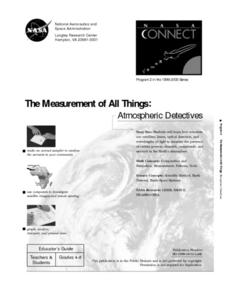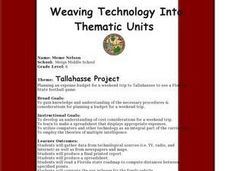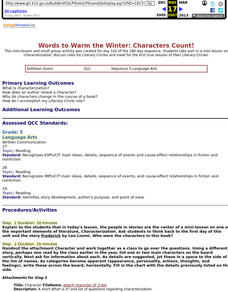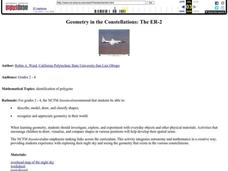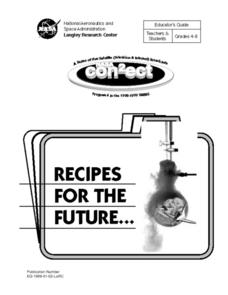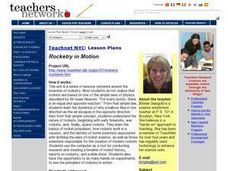Curated OER
Express Yourself!
Fifth graders study different types of poetry, compose a poem and word process it.
Curated OER
Falcon KWL Chart
Students create KWL charts about falcons. They write what they know about falcons and what they want to know about them. They read for information on falcons and complete the last column of their chart with the information they...
Curated OER
Bouncing Sunlight
Third graders use flashlights and balls to demonstrate how the light bounces off of the sun and reflects onto the moon. They record their observations in a journal.
Curated OER
The Measurement of All Things: Atmospheric Detectives
Students identify the characteristics of aerosols. Using remote sensing, they participate in an experiment in which they determine how the sun's radiation and elements in the atmosphere interact with one another. They also research the...
Curated OER
Water Color - Pen & Ink
Learners paint with watercolors, define positive and negative shapes, mix wet and wet colors, develop visual balance, and define shapes with pen and ink.
Curated OER
Tallahassee Project
Sixth graders gather information from technological sources such as TV, radio, and Internet as well as from newspapers and maps and produce a final printed report. They use the data to create a spreadsheet and read a Florida state...
Curated OER
An Introduction To Status
Students explore the concept of status and its use in theater. Using a scene from Shakespeare's play King Richard II, students work in pairs to perform the scene. After the performance, the pairs discuss their use of physical status in...
Curated OER
Probes, Exploration & Application
Students explore how a surface can be described without seeing it.
Curated OER
Sunspots and Climate
High schoolers make a graph that shows how the number of sunspots has changed over the past 30 years and discover how there is a pattern in sunspot number. They find a disruption in this pattern due to the Little Ice Age.
Curated OER
Classification: Dichotomous Key
Learners explain the classification process of organisms. In this biology lesson, students practice writing the names of organisms scientifically. They answer the dichotomous key and discuss answers as a class.
Curated OER
Lesson 2: Maine's Merchant Marines
Students simulate the quarters aboard a ship. They write a letter to Joanna Colcord or Alice Drinkwater that shows an understanding of the experience of being aboard ship, and asks further historical questions about the experience.
Curated OER
Words to Warm the Winter: Characters Count!
Fifth graders take part in a mini-lesson on characterization, discuss roles for Literary Circles and meet for the first true session of their Literary Circles.
Curated OER
Cooler in the Shadows
Students explore how the amount of sunlight and heat change in areas that are shaded.
Curated OER
Uchiwa Lesson Plan
Students view images from Japan's Summer Festival celebration. They create a uchiwa fan to use while doing the Kuma River Dance.
Curated OER
Graphing Data - Temperature
Seventh graders measure and record temperature over a given time period. They compare the recorded temperatures to the 40-year recorded normal average temperatures for the same area. Students display and interpret their findings in a graph.
Curated OER
Geometry in the Constellations: The ER-2
Students discuss reasons to record the location of stars. They view a picture of the night sky, and discuss constellations. Students complete a worksheet of the various shapes they see in the constellations.
Curated OER
Arts of Asia in Reach
Students explore the traditions and celebrations of another culture and research a city or community in Japan. They then examine traditional Japanese music as well as practice several dance steps and discover their significance in...
Curated OER
Recipes for the Future
Students engage in real time interactions with researchers and are exposed to innovative research. They conduct an experiment designed to investigate the strength and maximum deflection of a composite material with and without the use of...
Curated OER
Plane Weather
Young scholars examine the important issue of plane safety. In groups, they are introduced to how NASA determines if it is safe to fly on a particular day given certain conditions. They use the internet to research the types of tools...
Curated OER
Rocketry in Motion
Students investigate why a balloon flies in one direction as air escapes in the opposite direction, which helps them understand the nature of rockets and fireworks. Individually and in teams, students conduct research to create a...
Curated OER
Geographic Information Systems
Young scholars examine the concept of geographic information systems (GIS) and its basic components. They explore an application program using GIS technology and list the various uses for GIS.
Curated OER
Volcanoes: How Safe Are They?
Pupils explore the most dangerous volcanoes on Earth, plot their locations, and research different volcanic hazards.
Curated OER
Measuring Wind Speed
Fourth graders measure wind speed over a week's time uisng a ping pong and a protractor and graph the results. They convert the number of degrees to miles per hour using a scale. They discuss patterns and relationships.





